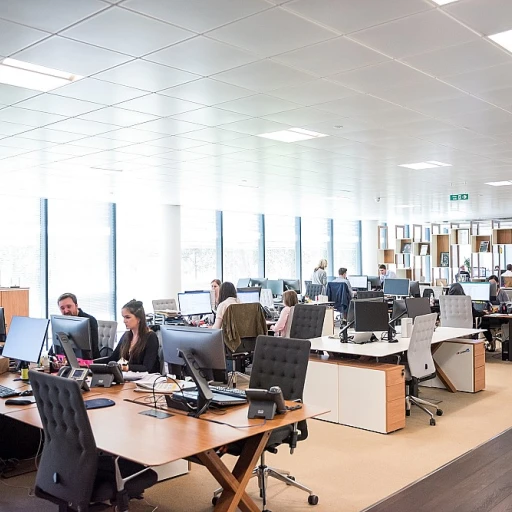The Basics of CAM Reconciliation
Grasping the Core Concepts of CAM Reconciliation
Understanding CAM reconciliation is crucial for anyone involved with commercial real estate in India. At its essence, CAM reconciliation revolves around the proper allocation and adjustment of common area maintenance (CAM) charges, which are expenses related to maintaining and operating common areas in a commercial property.
These expenses typically include costs associated with landscaping, security, cleaning, and other essential services required to keep the property functional and presentable for tenants. It's the landlord's responsibility to calculate these costs accurately, which are then distributed among tenants based on their pro rata share as specified in the lease agreement.
The reconciliation process comes into play at the end of each year. This is when property managers and landlords compare the estimated CAM expenses included in lease agreements with the actual costs incurred over the past year. The goal is to ensure that tenants pay only their fair share of common area expenses, striking a balance between covering maintenance costs and maintaining tenant satisfaction.
For office managers in Indian enterprises seeking to streamline efficiency and maintain financial foresight, a thorough understanding of CAM reconciliations is indispensable. By familiarizing oneself with the basics of this process, one gains insight into the vital interplay between landlords, property managers, and tenants, all striving for a transparent and efficient real estate management system. For more detailed insights on enhancing office management through such reconciliations, explore
streamlining efficiency and financial foresight for office managers.
The Process of CAM Reconciliation
Navigating the Steps of CAM Reconciliation
In Indian commercial real estate, conducting a thorough CAM reconciliation process is crucial for ensuring precise financial management. Let's delve into the detailed steps involved in this process, keeping in mind the various elements that necessitate attention.
Commercial lease agreements usually include CAM charges, where landlords recover expenses from tenants. These charges cover the maintenance of common areas shared by multiple tenants. Here's how the reconciliation process generally occurs:
- Data Collection:
- Property managers collect data on all expenses related to the maintenance of common areas. This includes items such as janitorial services, landscaping, and general upkeep.
- Expenses are aggregated to determine the total cost incurred over the year.
- Tenant Billing and Pro Rata Share Calculation:
- Once the total of all CAM expenses is established, landlords calculate the pro rata share for each tenant based on their lease agreements.
- This involves understanding the applicable lease accounting terms and the specific rata share of each tenant in the property.
- Expense Allocation Review:
- The CAM reconciliation process requires cross-verifying that all expenses have been accurately allocated only to those services benefitting the common areas.
- This helps avoid disputes and maintains transparency between landlords and tenants.
- Adjustments and Discrepancies:
- Miscommunications can occur, and discrepancies might be discovered during the reconciliation. This stage involves making necessary adjustments to ensure that actual costs meet the estimated expenses indicated to the tenants.
- Clear communication between the property management and the tenants is vital to resolve any discrepancies rapidly.
- Finalizing Reports:
- After confirming all adjustments, a final report is generated. This document outlines the CAM fees paid by each tenant versus the actual costs incurred by the landlord for the maintenance of the common areas.
Understanding the intricate details behind each step assures more precision and efficiency in managing CAM reconciliations. This is particularly pertinent given the variance in common area maintenance expenses in different types of commercial property. Managing this process with diligence is critical
for mastering financial accuracy.
Benefits of CAM Reconciliation for Indian Companies
Advantages of Implementing CAM Reconciliation
CAM reconciliation is a critical component of lease agreements that offers numerous benefits to Indian companies managing commercial properties. Ensuring accurate distribution of common area maintenance (CAM) expenses among tenants not only streamlines operations but also fortifies trust between property managers and tenants. Let's delve into the key advantages of adopting effective CAM reconciliation practices.
Firstly, proper CAM reconciliation leads to
transparency. By precisely detailing CAM charges, landlords can ensure tenants are only paying their pro rata share of expenses. This transparency fosters trust and reduces disputes related to hidden costs in lease agreements, promoting a harmonious leasing environment.
Secondly, employing a structured reconciliation process can result in significant
cost savings. By addressing discrepancies early and preventing overcharges, landlords can optimize their expense management. This diligent approach to handling costs fortifies lease agreements and, in turn, enhances the financial performance of commercial real estate investments.
Moreover, CAM reconciliation can serve as a tool to enforce accountability. When common area maintenance fees are accurately reported and tracked, landlords and property managers can better manage their budget allocations and forecast future expenses more effectively. This level of precision not only elevates operational efficiency but also supports long-term planning and investment strategies.
Additionally, robust CAM reconciliation practices lay the groundwork for
enhancing efficiency with Lean Six Sigma techniques. Streamlined processes can lead to improved workflow, reducing the time and effort spent on resolving tenant disputes. Through technological integration and process refinement, property management can operate with a higher degree of efficiency.
Finally, a well-executed CAM reconciliation strengthens
tenant relationships by eliminating ambiguities in the reconciliation process. When tenants are assured of fair and correct CAM charges, it cultivates a sense of trust and satisfaction, encouraging lease renewals and positive referrals.
By integrating CAM reconciliation as an essential element of property management, Indian companies can secure these substantial benefits and pave the way for sustainable growth in the competitive real estate market.
Challenges in CAM Reconciliation
Tackling the Challenges of CAM Reconciliation in Indian Enterprises
The intricate process of CAM reconciliation in Indian companies presents several challenges, primarily due to the complex nature of lease agreements and the sheer diversity of commercial properties. Indian landlords and property managers often find themselves grappling with these challenges when dealing with CAM expenses.
First, there is the issue of transparency and communication between landlords and tenants. Given the detailed nature of common area maintenance (CAM) charges, disputes can arise over the pro rata share of expenses. This involves a deep understanding of the lease agreement terms and how those terms align with actual expense allocations.
Secondly, the variability in the types of expenses included in CAM charges can lead to confusion. Different commercial real estate properties might categorize expenses differently, resulting in discrepancies during the reconciliation process. Landlords must ensure that all included costs, ranging from maintenance CAM to property management fees, are transparent and agreed upon.
Another challenge is the timing and accuracy of the reconciliation process itself. Property managers are required to keep meticulous records of all related expenses throughout the year. Delays in compiling this financial information can lead to difficulties in accurate and timely reconciliations.
Moreover, the frequent changes in regulations and tax implications in the Indian real estate sector also pose a significant challenge. These modifications can impact how CAM expenses are calculated and reconciled, necessitating up-to-date knowledge and expertise.
Ultimately, overcoming these challenges requires a collaborative effort between landlords, tenants, and property management teams, ensuring clear communication, accurate expense tracking, and adherence to best practices. Addressing these issues is crucial for a smoother CAM reconciliation process, ultimately enhancing the landlord-tenant relationship in Indian commercial properties.
Best Practices for Effective CAM Reconciliation
Proven Approaches for Seamless CAM Reconciliation
Conducting CAM reconciliations can present numerous challenges, yet adopting a structured approach can mitigate associated complexities. A few best practices can significantly enhance the reconciliation process, ensuring both landlords and tenants reap the benefits without unnecessary hurdles.
- Clear Communication: Open lines of communication between landlords and tenants foster trust and understanding. Clearly outlining the common area maintenance (CAM) charges and expenses in lease agreements aids in setting the right expectations from the outset. Property managers should ensure that the explanations of year-end reconciling adjustments are comprehensive and transparent.
- Consistent Documentation: Maintaining meticulous records of all commercial property expenses is imperative. Accurate, well-organized documentation aids in smooth reconciliation. This involves capturing every detail related to pro rata share calculations, cam fees, expenses, and other charges, reducing disputes over charges owed.
- Advanced Software Tools: Modern technology solutions provide invaluable support in managing the CAM reconciliation process. Software specifically designed for commercial real estate can automate data entry, calculating the cam fees and pro rata shares accurately, thereby significantly minimizing human errors.
- Regular Audits: Conducting periodic audits and reviews of the property management records helps ensure alignment between charges incurred and those billed to tenants. Regular audits support fair and transparent financial obligations for both landlords and tenants.
- Training and Education: Property managers should invest in ongoing training for their teams. Having a deep understanding of lease accounting, CAM reconciliation, and common expenses is crucial to handling tenant queries and executing lease agreements with precision.
By integrating these practices, Indian companies involved in property management can enhance the effectiveness of their CAM reconciliation processes and ensure a fair and transparent relationship with all parties involved.
The Future of CAM Reconciliation in India
Embracing Technological Integration in CAM Reconciliation
As Indian companies increasingly recognize the critical nature of CAM reconciliation, there's a noticeable shift towards integrating technology to streamline this process. Incorporating digital tools can substantially enhance the efficiency of CAM charges reconciliation by automating tedious manual tasks, minimizing errors, and improving accuracy.
Digital transformations also allow better real-time tracking of expenses, and landlords are now keen on using software that allows them to efficiently manage CAM fees, ensuring that tenants are accurately billed for their pro rata share of common area expenses. Such advancements additionally help in maintaining transparency between landlords and tenants, ultimately fostering better tenant-landlord relationships.
Moreover, digital reconciliation systems also support complex lease accounting. By leveraging advanced solutions, property managers can ensure that lease agreements are managed efficiently, thereby mitigating any potential disputes that may arise from mismanaged common area maintenance and expense reports.
It becomes clear that modernizing the reconciliation process with state-of-the-art property management software is the way forward for Indian companies operating in the commercial real estate sector. Embracing these innovations not only drives operational efficiency but also future-proofs businesses against the ever-evolving landscape of property management.
By adopting such advancements now, companies are not only addressing current challenges but are also paving the way for more streamlined, transparent, and efficient CAM reconciliation in the future.

